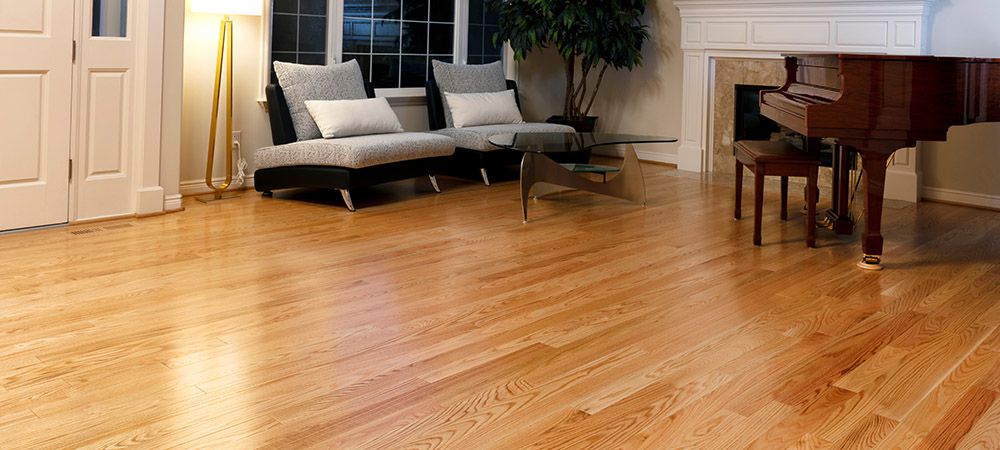There are several options you can consider when installing wood flooring in your home. These options include many domestic and exotic wood species. You have maple, white oak, red oak, pine, and many more varieties.
Not to mention, you can go for either solid or engineered hardwood in all cases. Your options are almost limitless with hardwood flooring.
However, the unlimited choices available may end up being a source of confusion if you’re not sure of what you want. And one of the most popular recommendations you’ll get is the red oak.
It’s pretty popular in Canada and for many good reasons. We’ll get to why shortly; after all, this post is a guide to red oak flooring. So we plan to provide exhaustive information about red oak and its application to flooring.
That said if you’re ready to give your home a fresh look, prepare to put some wood on your floors. Nothing can beat the warm, cozy feeling hardwoods as red oak brings into a home. So if you’re interested, let’s explore what to expect from red oak flooring and why you should go for it. But before that, let’s get to know the red oak.
What is Red Oak
Red oak is a tree species native to the Americas, particularly North America. You’ll typically find these trees growing around the southern parts of Canada and Northern United States. They grow alongside the white oak, and both wood species are the two most popular wood species across America and Canada.
Red oak has an assortment of about 40 categories and over 200 subspecies. Initially, the red oak flooring was a staple in European homes in the eighteenth century. However, it found its way into many contemporary designs across America and Canada. Now, it’s a prevalent flooring option among several homeowners worldwide.
How’s it Different From the White Oak?
People broadly categorize the majority of the oak tree species as either red or white oaks. Naturally, the two major oak species share a lot of similarities. For instance, it’s difficult to tell the two tree species apart while still alive. That’s because the bark of the white oak is not particularly white, nor is the bark of the live red oak specifically red.
However, they have notable differences that set each of them apart. For example, the bark of the red oak is a bit darker than the bark of the white oak. In addition, the red oak’s lumbar has a reddish-pink hue, while the white oak has a tan or light brown colour. These differences are quite subtle and may not be obvious to the untrained eyes.
If you look into the details of both wood species, you’ll also notice that the red oak has more open cells. This characteristic makes the red oak more receptive to varnishes as its pores allow more fluids to pass through. On the other hand, the white oak has its pores blocked up by outgrowths.
Also, the grains of the red oak are slightly smaller than those of the white oak. Red oaks typically have grains extending for about ½ inch, while the white oak’s grains can be as large as a whole inch. This characteristic also gives the red oak a rougher grain appearance.
Nonetheless, the appearance of the red oak is stunningly beautiful. It has an even flow ambience which creates a consistent gradient across the floor surface.
Features of the Red Oak
Understanding the intricacies and characteristics of red oak is essential to identifying if it’s the right choice for you. Then again, we can’t call this post a guide to red oak floors without considering the features of the subject. That said, let’s look at some of the distinct characteristics of red oak flooring.
Red Oak Hardness
Red oak ranks in the midrange in hardness considerations. With a Janka hardness rating of 1290 out of 4000, it falls within a reasonable range of the tough hardwood flooring options. Nonetheless, the red oak comes a bit short of its close relative, the white oak, in this regard. The white oak has a rating of 1360. However, the difference is still very much within an acceptable range.
For those who might not understand, the Janka hardness scale is a metric for determining the strength of wood species. You can use this scale to understand the resistance of various hardwoods to dents, dings and scratches. The test measures the pound per square inch force it’ll take to embed a 2″ x 2″ x 6″ steel ball halfway into the wood.
In other words, it’ll take 1290 pounds per square inch of force to embed a 2″ x 2″ x 6″ steel ball halfway into a piece of red oak. That’s quite strong, in our opinion. For comparison, mahogany has a rating of 2200, and maple has a rating of 1450.
Woods at the top of the Janka hardness scale have more resistance to dings, but they’re difficult to use for floorings. On the other hand, woods on the lower end of the scale are more flexible but much weaker. As a result, these wood species are more susceptible to dents and scratches.
Red Oak Appearance
We’ve made numerous references to the appearance of the red oak flooring already in this guide. So, you should already have an idea of what red oak hardwood typically looks like. One of the more prominent features of the red oak is its wide grain pattern. While its grain pattern may not be as wide as the white oak’s, It’s still larger than most tree species.
The grain patterns are pretty obvious, so you can easily spot them on the floor when you use red oak for your flooring. The red oak has a coarse grain texture due to its uneven grain pattern. Not only that, but the red oak also has a distinctive reddish-pink hue with larger and more absorbent pores.
The open porous grains reveal the actual characteristics of the hardwood and add to its appeal. Plus, while the reddish-pink hue is already beautiful, you can easily stain the woods to any colour you prefer.
Red Oak Workability
Workability refers to the ease with which woodworkers can craft a type of wood for specific purposes. In this case, the workability of a red oak refers to how easily manufacturers can use it to make flooring materials.
Generally, people consider two poles of extreme durability and extreme flexibility when looking at hardwood options. As we said earlier, the highly durable options are harder to cut up, while the extremely flexible ones are more easily damaged. Fortunately, the red oak falls somewhere between these two extremes. It’s the perfect combination of durability and flexibility.
As such, the red oak is one of the best choices in workability considerations. It’s easy to saw and machine individual planks of red oak. It’s even easier to sand if you follow the correct sanding sequence. Overall, it’s quite straightforward to work with, and it has sufficient resistance to dents and dings.
Related Article: Is Maple Good for Hardwood Floors?
Benefits of Red Oak

Red oak wood flooring has numerous benefits, as you’ll discover in this guide. We’ve already established its extreme durability as well as workability, among its other features. However, the advantages of the red oak flooring are much more than that. Below are some additional pros of installing red oak flooring in your apartment.
Above-average stability
Stability refers to the ability of a wood species to respond and acclimatise to different moisture levels in an environment. In other words, it’s the capabilities of a wood species to shrink or expand according to the atmospheric condition in a place without losing structural integrity.
That said, the red oak has a remarkable ability to adapt to different environments optimally. Given enough time, the red oak will shrink or expand as much as the atmospheric condition in an environment necessitates it. The red oak takes it all in its stride without so much as cracking or chipping.
Therefore, we’ll categorize the red oak as one of the best options when it comes to stability. Red oak even has more stability than hickory and maple. So it’s a safer bet if you’re moving into an environment with significantly higher or lower levels of moisture.
Easy to Stain and Customize
If you’d like to customize the shade or colour on your hardwood floors as you want, you should install red oak flooring. While it naturally spots a reddish-pink colour, it’s effortless to stain and repaint.
Thanks to the porosity of the red oak, stains, varnishes and other colour options can quickly get into the grains of the wood. So, it’s easier to get a consistent, even colour throughout a red oak regardless of the hue you opt for.
Multiple grain pattern options
One of the fascinating features of the red oak flooring is also a benefit that people overlook. You get to pick between at least three grain patterns for the same type of wood. The three main patterns you can select from include;
Plain-sawn: This pattern typically spots a flared or plumed grain appearance. Therefore it has the most pronounced grain style of any red oak hardwood floor.
Rift-sawn: Rift-sawn red oak boards have a tighter grain pattern, giving them a more subdued appearance. This grain pattern is perfect if you’re going for a minimalist style such as the Nordic design.
Quarter-sawn: Quarter-sawn boards find a balance point between plain and rift-sawn boards. They have a flaky pattern that many woodworkers call butterflies or tiger rays. Plus, this flaky pattern is often more apparent in Red oaks than other wood species.
The three patterns are dependent on how the wood is cut. I.e. woodworkers create those patterns by cutting and sanding the woods using specific techniques. But overall, the coarse grain of the red oak gives it a more natural and woody appearance than most other wood species. So, if you prefer a rustic-looking floor, you’ll like the red oak.
Versatility and Functionality
A guide to red oak flooring will not be complete without a reference to the versatility of the wood species. Red oak is durable enough to be suitable for a space that experiences a lot of traffic and has enough character to work in a more luxurious setting. It can represent both ends of the spectrum effortlessly and efficiently.
So, you can install it in a busy area like your living room or a more private space like your personal study. It works well in casual and professional environments. Did we mention it was a staple in most classical luxurious designs? It was a common sight in high estates, manors and other regal settings in the eighteenth century. And now, it’s found its way into various contemporary designs.
Then again, if you’re a woodworker trying to decide which wood species is best for your next flooring project, try the red oak. While it’s sufficiently hard, it won’t take you a ton of effort to carve up. And you can do a mighty fine job with the red oak if you have the right tools and motivation.
Sufficient Toughness and Durability
We’ve already discussed the hardness of the red oak flooring earlier in this guide. However, we can’t overstate such a prominent advantage of red oak flooring. Note that hardness is a bit different from durability. Most people tend to confuse the two terms. However, they’re not the same.
Hardness refers to how easily an object can withstand concentrated pressure for a short while. On the other hand, durability describes how long and how well an object can withstand all forms of pressure. Nonetheless, the two concepts are interwoven, so people tend to confuse them.
That said, the red oak may not have extreme hardness, but it’s pretty durable. I.e. it can last for a significant timespan under constant use.
Important considerations when Installing Red Oak Hardwood Flooring
For this to be a comprehensive guide to red oak flooring, we need to look at some crucial factors you need to consider when going for red oak. Below are two of those factors.
Solid Hardwood Flooring vs. Engineered Wood Flooring
Originally, you’ll typically find red oak as solid hardwoods. However, engineers have been able to fashion an alternative form. Nowadays, you can easily get engineered variants of red oak wood. The engineered red oak is not very different from the solid one in appearance. However, they’re very distinct in features, benefits and capabilities.
For example, Solid red oak has a more natural grain appearance and adds more character to the home. On the other hand, the engineered red oak has a more consistent appearance and finer-looking grains.
Not only that, you can refinish solid red oak numerous times due to its natural ruggedness. On the other hand, the number of times you can refinish engineered red oak is limited. As such, solid red oaks often last longer than engineered red oak.
Furthermore, engineered red oak is more affordable. Also, they don’t warp as easily as solid red oaks. As such, they’re more suitable for high-moisture areas. So they’re the better option for you if you’re moving into an environment that experiences dramatic climate changes regularly.
Pre-finished or unfinished red oak hardwood flooring
After deciding between solid and engineered slats, you’ll still have to pick either pre-finished or unfinished red oak for your floors. Manufacturers usually design the planks to come in these two variants.
The pre-finished planks come with stains of a particular shade from the manufacturer. So, you won’t have to bother with adding pigments when you buy red oak flooring. However, this option costs more to get. But, it’s advantageous if you find the perfect colour for your overall design theme.
You can also buy the unfinished red oak. These variants cost less and give you more freedom to design the floors as you like. Then again, you can leave it unfinished and let it retain its natural hue. However, it will cost you money and effort if you later decide to stain it.
Red Oak Flooring Installation guide
Now that you know the basics about red oak, you probably want to already put it in your apartment. Alright, then let’s look at how to install red oak flooring in an apartment.
- You should start by preparing your subfloor. Make sure it’s solid, smooth and free of moisture.
- Next, place an underlayment on the subfloor.
- After that, lay down the slats on the underlayment. You may need to use an adhesive to hold the slats down. Also, don’t forget to leave spaces for expansion. So, put spacers along the sides of the wall to leave the necessary spaces.
- Layout the design pattern you want on the floor and then trim out excesses. Finally, hammer down the setup with a mallet until it’s well secured.
Related Article: How Much Does it Cost To Install Herringbone Wood Floors?
Final Thoughts
Red oak makes for an ideal flooring material for many homeowners, and it’s easy to see why from this guide. It offers a distinctive grain, has sufficient durability and is versatile to fit various design themes. It’s also easily customizable by staining and will take well with any stain colour. So if you’re asking, “should I install red oak flooring?” There you have your answer.
Check out our online store for red oak flooring designs. You can also talk to our experts at LV Flooring about the flooring options you’re looking for. You’re sure to find something that’ll suit your preferences here.


